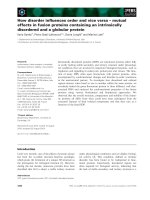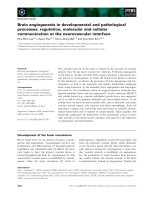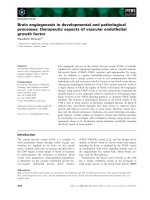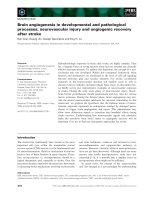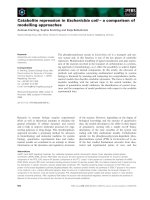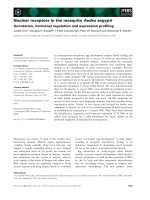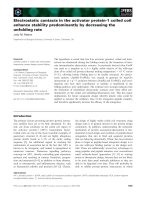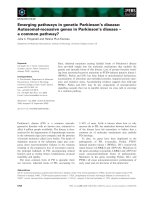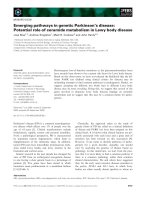Báo cáo khoa học: Deficiency in apolipoprotein E has a protective effect on diet-induced nonalcoholic fatty liver disease in mice pot
Bạn đang xem bản rút gọn của tài liệu. Xem và tải ngay bản đầy đủ của tài liệu tại đây (606.7 KB, 11 trang )
Deficiency in apolipoprotein E has a protective effect on
diet-induced nonalcoholic fatty liver disease in mice
Eleni A. Karavia
1
, Dionysios J. Papachristou
2
, Ioanna Kotsikogianni
2
, Ioanna Giopanou
2
and
Kyriakos E. Kypreos
1
1 Department of Medicine, Pharmacology Unit, University of Patras School of Health Sciences, Rio-Achaias, Greece
2 Department of Medicine, Anatomy, Histology and Embryology Unit, University of Patras School of Health Sciences, Rio-Achaias, Greece
Keywords
apoE-deficient mice; apolipoprotein E; low
density lipoprotein receptor; lipoproteins;
nonalcoholic fatty liver disease
Correspondence
K. E. Kypreos, Department of Medicine,
University of Patras School of Health
Sciences, Panepistimioupolis, Rio,
TK 26500, Greece
Fax: +302610994720
Tel: +302610969120
E-mail:
(Received 21 March 2011, revised 7 June
2011, accepted 6 July 2011)
doi:10.1111/j.1742-4658.2011.08238.x
Apolipoprotein E (apoE) mediates the efficient catabolism of the
chylomicron remnants very low-density lipoprotein and low-density lipo-
protein from the circulation, and the de novo biogenesis of high-density
lipoprotein. Lipid-bound apoE is the natural ligand for the low-density
lipoprotein receptor (LDLr), LDLr-related protein 1 and other scavenger
receptors. Recently, we have established that deficiency in apoE renders
mice resistant to diet-induced obesity. In the light of these well-documented
properties of apoE, we sought to investigate its role in the development of
diet-induced nonalcoholic fatty liver disease (NAFLD). apoE-deficient,
LDLr-deficient and control C57BL ⁄ 6 mice were fed a western-type diet
(17.3% protein, 48.5% carbohydrate, 21.2% fat, 0.2% cholesterol, 4.5 kca-
lÆg
)1
) for 24 weeks and their sensitivity to NAFLD was assessed by histo-
logical and biochemical methods. apoE-deficient mice were less sensitive
than control C57BL ⁄ 6 mice to diet-induced NAFLD. In an attempt to
identify the molecular basis for this phenomenon, biochemical and kinetic
analyses revealed that apoE-deficient mice displayed a significantly delayed
post-prandial triglyceride clearance from their plasma. In contrast with
apoE-deficient mice, LDLr-deficient mice fed a western-type diet for
24 weeks developed significant accumulation of hepatic triglycerides and
NAFLD, suggesting that apoE-mediated hepatic triglyceride accumulation
in mice is independent of LDLr. Our findings suggest a new role of apoE
as a key peripheral contributor to hepatic lipid homeostasis and the devel-
opment of diet-induced NAFLD.
Introduction
Apolipoprotein E (apoE) is a 34.2-kDa glycoprotein
synthesized by the liver and other peripheral tissues. In
humans, there are three major natural isoforms,
apoE2, apoE3 and apoE4, with apoE3 being the most
common [1–7]. apoE is a major protein component of
chylomicron remnants and very low-density lipoprotein
(VLDL) [1]. The importance of this protein in
the maintenance of plasma lipid homeostasis and ath-
eroprotection was first established with the generation
of the apoE-deficient mouse [8,9], which develops
Abbreviations
apoE, apolipoprotein E; apoE
) ⁄ )
, apoE deficient; apoE3
knock-in
mice, mice containing a targeted replacement of the mouse apoE gene for the
human apoE3 gene; FFA, free fatty acid; HDL, high-density lipoprotein; IDL, intermediate density lipoprotein; LDL, low-density lipoprotein;
LDLr, low-density lipoprotein receptor; LDLr
) ⁄ )
, LDLr deficient; NAFLD, nonalcoholic fatty liver disease; VLDL, very low-density lipoprotein;
WT, wild-type.
FEBS Journal 278 (2011) 3119–3129 ª 2011 The Authors Journal compilation ª 2011 FEBS 3119
hypercholesterolemia and spontaneous atherosclerosis
[8,9].
Recently, using apoE-deficient (apoE
) ⁄ )
) mice,
C57BL ⁄ 6 mice and apoE3
knock-in
mice (mice containing
a targeted replacement of the mouse apoE gene for the
human apoE3 gene), we have shown that, in addition
to its role in the maintenance of plasma lipid homeo-
stasis, apoE plays a central role in the development of
diet-induced obesity and related metabolic dysfunc-
tions in mice [10,11]. Additional studies in genetically
predisposed obese mice further confirmed that defi-
ciency in apoE protects mice from obesity, insulin
resistance and other metabolic abnormalities [12,13].
Nonalcoholic fatty liver disease (NAFLD) is a spec-
trum of metabolic abnormalities ranging from simple
accumulation of triglycerides in the liver (hepatic stea-
tosis) to hepatic steatosis with inflammation, fibrosis
and cirrhosis (steatohepatitis) [14,15]. Although hepatic
steatosis is related to a number of clinical disorders
and has been studied in several different animal mod-
els, NAFLD in humans is characterized by obesity,
insulin resistance and associated metabolic perturba-
tions [14,15]. For this reason, it has been proposed
that NAFLD should be included as a component of
metabolic syndrome [16]. Aging, hormonal imbalance
and genetic predisposition may contribute to hepatic
triglyceride accumulation. However, a western-type
diet and sedentary lifestyle, which result in excess body
fat, physical inactivity and imbalance in caloric load,
are the most common contributors to NAFLD [17].
As apoE possesses a central role in the metabolism
of plasma lipoproteins and the development of diet-
induced obesity, in this study we sought to determine
how apoE affects the development of diet-induced
NAFLD in mice. To address this question 10–12-
week-old male apoE
) ⁄ )
and wild-type (WT) C57BL ⁄ 6
mice were fed a standard western-type diet (17.3%
protein, 48.5% carbohydrate, 21.2% fat, 0.2% choles-
terol, 4.5 kcalÆg
)1
) for 24 weeks, and histological and
biochemical analyses were performed. We found that
deficiency in apoE has a protective effect on diet-
induced hepatic triglyceride accumulation, and the
apoE-mediated development of diet-induced NAFLD
in mice is independent of the low-density lipoprotein
receptor (LDLr). Our data establish that apoE plays a
central role in the deposition of post-prandial triglyce-
rides in the liver and NAFLD which, over long periods
of time, may lead to nonalcoholic steatohepatitis.
Results
apoE
) ⁄ )
mice are less sensitive than control
C57BL
⁄
6 mice to hepatic triglyceride
accumulation
To test the effects of apoE on hepatic triglyceride
accumulation, groups of 10–12-week-old male apoE
) ⁄ )
and WT C57BL ⁄ 6 mice were placed on a western-type
diet for a total period of 24 weeks. As shown
in Fig. 1A, hematoxylin and eosin staining of liver
AB
C D
Fig. 1. Histological analyses of liver
sections from apolipoprotein E-deficient
(apoE
) ⁄ )
) and C57BL ⁄ 6 mice. (A, B) Repre-
sentative photographs of hematoxylin and
eosin-stained hepatic sections from apoE
) ⁄ )
(A) and C57BL ⁄ 6 (B) mice at week 24 on a
western-type diet. (C, D) Representative
photographs of reticulin-stained hepatic sec-
tions of apoE
) ⁄ )
(C) and C57BL ⁄ 6 (D) mice
fed a western-type diet for 24 weeks. All
photographs were taken at an original
magnification of ·20.
Apolipoprotein E and diet-induced NAFLD E. A. Karavia et al.
3120 FEBS Journal 278 (2011) 3119–3129 ª 2011 The Authors Journal compilation ª 2011 FEBS
sections revealed that deficiency in apoE did not result
in any significant distortion of liver microscopic mor-
phology or accumulation of triglycerides in the liver of
apoE
) ⁄ )
mice fed a western-type diet for 24 weeks. In
contrast, control C57BL ⁄ 6 mice fed a western-type diet
for the same period exhibited remarkable steatosis,
characterized by excessive accumulation of lipids
within liver cells (Fig. 1B). The observed steatosis was
diffuse and of the macrovesicular type. Statistical anal-
ysis following histomorphometric evaluation of the
hematoxylin and eosin-stained sections revealed that
the number of lipid droplets within liver hepatocytes
was significantly elevated in C57BL ⁄ 6 relative to
apoE
) ⁄ )
mice (P = 0.0001). In agreement with these
data, staining of hepatic sections with reticulin showed
that, in C57BL ⁄ 6 mice fed a western-type diet for
24 weeks, NAFLD had progressed much more exten-
sively and had resulted in significant disruption in the
normal architecture of the extracellular reticulin fibrils
of the liver (Fig. 1D), relative to apoE
) ⁄ )
mice
(Fig. 1C) that displayed a normal hepatic histology.
No significant differences in the size and shape of vis-
ceral adipocytes were detected between the two groups
of mice (data not shown).
To further confirm that deficiency in apoE prevented
the accumulation of hepatic triglycerides in the liver of
mice fed a western-type diet for 24 weeks, liver sam-
ples were isolated from apoE
) ⁄ )
and C57BL ⁄ 6 mice
and their triglyceride contents were determined bio-
chemically, as described in the Materials and methods
section. This analysis showed that apoE
) ⁄ )
mice fed a
western-type diet for 24 weeks had a triglyceride
content of 98.6 ± 16.7 mgÆ(g hepatic tissue)
)1
, whereas
C57BL ⁄ 6 mice had a much higher hepatic triglyceride
content [155.7 ± 1 0 m gÆ(g hepatic tissue)
)1
; P < 0.005],
further confirming that apoE possesses a central
role in the deposition of dietary triglycerides in the
liver of mice and the development of diet-induced
NAFLD (Fig. 2D).
Body weight measurements and body
composition analysis of mice fed a western-type
diet for 24 weeks
As expected from previously published results,
apoE
) ⁄ )
mice were less sensitive than C57BL ⁄ 6 mice
to the development of diet-induced obesity [10,18].
Specifically, during the course of the experiment,
apoE
) ⁄ )
mice showed only a modest increase in body
weight (Fig. 2A). At week 6 of the experiment, the
apoE
) ⁄ )
mouse group had an average body weight of
26.7 ± 0.6 g (5.52 ± 1.45% increase relative to their
0 6 12 18 24
0
50
100
150
200
250
300
apoE
–/–
C57BL/6
**
**
**
**
Weeks
% of initial body weight
0
25
50
75
100
125
150
175
200
C57BL/6
apoE
–/–
**
Hepatic Triglyceride
content [mg Tg·(g tissue)
–1
]
10
10
0
6
12
18
24
0
250
500
750
1000
1250
1500
** **
**
Weeks
Cholesterol (mg·dL
–1
)
0 6 12 18 24
0
50
100
150
200
Weeks
Triglycerides (mg·dL
–1
)
0 1 2 3 4 5 6 7 8 9
0
1
2
3
4
5
6
7
8
9
10
Fraction number
Triglycerides (mg·dL
–1
)
CHYL/VLDL/IDL
HDL
0 1 2 3 4 5 6 7 8 9
0
25
50
75
100
125
150
175
200
CHYL/VLDL/IDL
HDL
Fraction number
Cholesterol (mg·dL
–1
)
AD
BE
CF
Fig. 2. Biochemical parameters of apolipo-
protein E-deficient (apoE
) ⁄ )
) and C57BL ⁄ 6
mice fed a western-type diet for a period of
24 weeks. (A) Changes in average body
weight. (B, C) Changes in average plasma
cholesterol and plasma triglycerides, respec-
tively. (D) Average hepatic triglyceride con-
tent of mice fed a western-type diet for
24 weeks (**P < 0.005). (E, F) Cholesterol
and triglyceride contents, respectively, of
the different density fractions following the
separation of plasma lipoproteins by density
gradient ultracentrifugation. Fraction 1 corre-
sponds to the top fraction [containing chylo-
microns (CHYL) and very low-density
lipoprotein (VLDL)]. HDL, high-density
lipoprotein; IDL, intermediate-density
lipoprotein; Tg, triglyceride.
E. A. Karavia et al. Apolipoprotein E and diet-induced NAFLD
FEBS Journal 278 (2011) 3119–3129 ª 2011 The Authors Journal compilation ª 2011 FEBS 3121
starting weight of 25.7 ± 0.2 g at week 0, P < 0.05).
At week 12, their average body weight was
30.7 ± 1.1 g and, at week 24, it showed a further
slight increase to 31.6 ± 1.7 g (19.7 ± 7.3% increase
relative to their starting weight at week 0, P < 0.05)
(Fig. 2A). In contrast, C57BL ⁄ 6 mice showed a signifi-
cant increase in their body weight during the course of
the experiment. At week 6, C57BL ⁄ 6 mice had an
average body weight of 31.8 ± 1.7 g (23.5 ± 3.9%
increase relative to their starting weight of 25.8 ± 1 g
at week 0, P < 0.05). At week 12, their body weight
was 35.3 ± 0.6 g and, at week 24, it showed a further
increase to 42.8 ± 1.7 g (66.7 ± 5.6% increase rela-
tive to their starting weight at week 0, P < 0.05)
(Fig. 2A). In agreement with our previous findings
[10], the increased body weight of C57BL ⁄ 6 mice cor-
responds to an increased body fat mass (data not
shown).
Plasma lipid levels and average daily food
consumption of mice fed a western-type diet for
24 weeks
To determine how plasma lipid levels may reflect differ-
ences in hepatic triglyceride accumulation in apoE
) ⁄ )
and C57BL ⁄ 6 mice, fasting plasma samples were iso-
lated every 6 weeks and cholesterol, triglyceride and free
fatty acid (FFA) levels were measured as described
in the Materials and methods section. As shown
in Fig. 2B, apoE
) ⁄ )
mice showed a dramatic increase in
their plasma cholesterol levels during the course of the
experiment. At week 24 of the experiment, the plasma
cholesterol levels of apoE
) ⁄ )
mice were 1475 ±
48 mgÆdL
)1
(Fig. 2B), whereas their plasma triglyceride
levels increased but remained within the physiological
range (126.7 ± 60.9 mgÆdL
)1
at week 24 versus
18.3 ± 1.9 mgÆdL
)1
at week 0) (Fig. 2C). Ultracentrifu-
gation analysis of plasma samples showed that the
hypercholesterolemia of these mice was caused by the
increased accumulation of triglyceride-containing cho-
lesterol-rich chylomicron remnants (Fig. 2E,F). How-
ever, C57BL ⁄ 6 mice on a high-fat diet for 24 weeks
showed slightly elevated fasting cholesterol levels
(224.6 ± 21 mgÆdL
)1
) relative to their starting choles-
terol levels at week 0 (91.9 ± 10 mgÆdL
)1
) (Fig. 2B),
whereas their plasma triglyceride levels remained normal
(79.4 ± 7.4 mgÆdL
)1
at week 24 versus 58.2 ±
1.1 mgÆdL
)1
at week 0) (Fig. 2C). Ultracentrifugation
analysis of plasma samples showed that the cholesterol
of these mice was mainly distributed in the high-density
lipoprotein (HDL) fractions (Fig. 2E,F).
Surprisingly, apoE
) ⁄ )
mice, which do not develop
NAFLD, had a higher plasma concentration of
FFAs than C57BL ⁄ 6 mice. Steady-state FFA levels
of apoE
) ⁄ )
mice were 7.6 ± 1.2 mmol eq., whereas
C57BL ⁄ 6 mice showed a much lower steady-state
plasma FFA concentration of 1.4 ± 0.1 mmol eq. (P =
0.0001).
To determine whether differences in hepatic triglycer-
ide accumulation could be explained by differences in
the average daily food consumption between the two
groups of mice, at weeks 12 and 24 of the experiment
we determined the average daily food consumption for
each mouse group. It was found that apoE
) ⁄ )
mice
consumed 3.3 ± 0.2 and 3.5 ± 0.6 gÆmouse
)1
Æday
)1
at
weeks 12 and 24, respectively (P > 0.05). Similarly,
C57BL ⁄ 6 mice consumed 3.8 ± 0.2 and 3.4 ±
0.2 gÆmouse
)1
Æday
)1
at weeks 12 and 24, respectively
(P > 0.05). There was no statistically significant differ-
ence between the two groups (P > 0.05). Although, in
this study (n = 5), we were unable to determine a
statistically significant difference in the average daily
food consumption between the two mouse strains at
week 12 of the experiment (3.3 ± 0.2 versus 3.8 ±
0.2 gÆmouse
)1
Æday
)1
for apoE
) ⁄ )
and C57BL ⁄ 6 mice,
respectively; P = 0.0833), a trend towards lower food
consumption existed for the apoE
) ⁄ )
mice. A future
larger trial may be useful to confirm the similar average
food consumption observed in the present study.
Rate of hepatic triglyceride secretion and
intestinal triglyceride absorption in apoE
) ⁄ )
and
C57BL
⁄
6 mice
One mechanism that could affect the hepatic triglycer-
ide content is the secretion of hepatic triglycerides in
the circulation. To determine the contribution of VLDL
triglyceride secretion in apoE-mediated hepatic lipid
accumulation, we compared the rate of hepatic VLDL
triglyceride secretion between apoE
) ⁄ )
and C57BL ⁄ 6
mice. In accordance with previous studies [19–21], we
found that the rate of hepatic triglyceride secretion
decreased significantly in apoE
) ⁄ )
relative to C57BL ⁄ 6
mice. Specifically, secretion rates were 2.1 ± 0.4 mgÆ-
dL
)1
Æmin
)1
(minimum, 1.7 mgÆdL
)1
Æmin
)1
; maximum,
3.5 mgÆdL
)1
Æmin
)1
; SEM = 0.4, n = 5) for apoE
) ⁄ )
mice versus 11.2 ± 0.9 mgÆdL
)1
Æmin
)1
(minimum,
9.8 mgÆdL
)1
Æmin
)1
; maximum, 13.7 mgÆdL
)1
Æmin
)1
;
SEM = 0.9, n = 5) for C57BL ⁄ 6 mice (P = 0.0001)
(Fig. 3A). Thus, on the basis of these results, it appears
that hepatic triglyceride secretion cannot account for
the differences in hepatic triglyceride deposition seen
between apoE
) ⁄ )
and C57BL6 mice.
One additional mechanism that could explain the
increased sensitivity of apoE
) ⁄ )
mice to diet-induced
NAFLD could be increased intestinal secretion of
Apolipoprotein E and diet-induced NAFLD E. A. Karavia et al.
3122 FEBS Journal 278 (2011) 3119–3129 ª 2011 The Authors Journal compilation ª 2011 FEBS
triglyceride-rich lipoproteins in the plasma of these
mice. To determine the rate of intestinal triglyceride
secretion, we calculated the total rate (intestinal and
hepatic) of plasma triglyceride input in apoE
) ⁄ )
and
C57BL ⁄ 6 mice fed a western-type diet, following an
oral fat load. Groups of five apoE
) ⁄ )
and C57BL ⁄ 6
mice were fasted for 16 h, and then given an oral fat
load of 300 lL of olive oil, as described in the Materi-
als and methods section. One hour post-gavage, mice
were injected with Triton WR1339 and plasma triglyc-
eride levels were determined as a function of time. As
shown in Fig. 3B, apoE
) ⁄ )
mice showed a lower rate
of total triglyceride input than C57BL ⁄ 6 mice. Specifi-
cally, the rates were 11.9 ± 1.3 mgÆdL
)1
Æmin
)1
for
apoE
) ⁄ )
mice and 14.5 ± 1.2 mgÆdL
)1
Æmin
)1
for
C57BL ⁄ 6 mice (n =5,P = 0.023). Then, by subtract-
ing the rate of hepatic triglyceride secretion (deter-
mined above) from the total rate of plasma triglyceride
supply, the rate of intestinal triglyceride secretion was
determined as 9.8 ± 1.3 mgÆdL
)1
Æmin
)1
for apoE
) ⁄ )
mice and 2.0 ± 0.7 mgÆdL
)1
Æmin
)1
for C57BL ⁄ 6
mice (n =5,P = 0.023). The data suggest that differ-
ences in intestinal triglyceride absorption or hepatic
triglyceride secretion cannot account for the observed
histological differences between apoE
) ⁄ )
and C57BL ⁄ 6
mice.
Kinetics of post-prandial triglyceride clearance in
apoE
) ⁄ )
and C57BL
⁄
6 mice
Another potential mechanism that could explain the
reduced sensitivity of apoE
) ⁄ )
mice to diet-induced
NAFLD could be reduced clearance of plasma trigly-
cerides in these mice. Thus, in the next set of
experiments, we sought to determine the kinetics of
post-prandial triglyceride clearance. As shown in
Fig. 3C, following gavage administration of olive oil,
the mouse groups reached similar maximum plasma
concentrations of 142.7 ± 29.6 and 161.4 ± 21.5
mgÆdL
)1
, respectively, at 120 min post-gavage (n =5,
P = 0.2195) (Fig. 3C). However, there was a signifi-
cant difference in post-prandial triglyceride clearance
in apoE
) ⁄ )
mice relative to C57BL ⁄ 6 mice. In particu-
lar, in C57BL6 mice, the rapid increase in plasma
triglyceride levels at 120 min after olive oil administra-
tion was followed by an immediate and steep decline.
At 240 min post-gavage, the plasma triglycerides of
C57BL ⁄ 6 mice reached baseline levels
(59.5 ± 10.7 mgÆdL
)1
; minimum, 20.7 mgÆdL
)1
; maxi-
mum, 80.8 mgÆdL
)1
; SEM = 10.7). However, in
apoE
) ⁄ )
mice, a similar increase in plasma triglyceride
levels at the 2-h time point persisted over the period of
the next 4 h (360 min), suggesting that, in the absence
of apoE, post-prandial triglycerides are cleared from
the circulation at a significantly slower rate. At
240 min post-gavage, the plasma triglycerides of
apoE
) ⁄ )
mice were still significantly elevated
(137.5 ± 21.9 mgÆdL
)1
; minimum, 106.5 mgÆdL
)1
;
maximum, 184.0 mgÆ dL
)1
; SEM = 21.9).
LDLr-deficient (LDLr
) ⁄ )
) mice fed a western-type
diet for 24 weeks developed significant
accumulation of hepatic triglycerides and NAFLD
To address the potential role of LDLr in the apoE-
mediated deposition of dietary triglycerides in the liver,
low density lipoprotein receptor-deficient (LDLr
) ⁄ )
)
mice were fed a western-type diet for 24 weeks and
liver specimens were isolated and analyzed for triglyc-
eride content by biochemical and histological analyses.
apoE
–/–
C57BL/6
0
5
10
15
**
Rate of hepatic
VLDL-triglyceride
secretion (mg·dL
–1
·min
–1
)
60 90 120 150 180
0
500
1000
1500
2000
apoE
–/–
C57BL/6
Time (min)
Triglycerides (mg·dL
–1
)
Slope
apoE
–/–
=11.9 ± 1.3 (mg·dL
–1
·min
–1
)
Slope
C57BL/6
=14.5 ± 1.2 (mg·dL
–1
·min
–1
)
0 30 60 90 120 150 180 210 240 270 300 330 360
0
50
100
150
200
C57BL/6
apoE
–/–
**
**
Time post-gavage (min)
Plasma triglycerides
(mg·dL
–1
)
A
B
C
Fig. 3. Analysis of kinetic parameters associated with hepatic tri-
glyceride content. (A) Rate of hepatic very low-density lipoprotein
(VLDL) triglyceride secretion. (B) Rate of total triglyceride supply in
plasma in apolipoprotein E-deficient (apoE
) ⁄ )
)(h) and C57BL ⁄ 6(m)
mice. (C) Kinetics of post-prandial triglyceride clearance in apoE
) ⁄ )
(h) and C57BL ⁄ 6( ) mice. **P < 0.005.
E. A. Karavia et al. Apolipoprotein E and diet-induced NAFLD
FEBS Journal 278 (2011) 3119–3129 ª 2011 The Authors Journal compilation ª 2011 FEBS 3123
In agreement with our previous studies, LDLr
) ⁄ )
mice
were more susceptible than apoE
) ⁄ )
mice to diet-
induced obesity, but more resistant than C57BL ⁄ 6
mice [10]. Surprisingly, however, we found that hepatic
specimens from LDLr
) ⁄ )
mice showed a higher triglyc-
eride content than those of control C57BL⁄ 6 mice
[233.0 ± 19 versus 155.7 ± 10 mgÆ(g hepatic tissue)
)1
,
respectively]. Our biochemical results were in agree-
ment with data from our histological analyses, which
showed that LDLr
) ⁄ )
mice developed NAFLD that
had progressed even more than that of control
C57BL ⁄ 6 mice. Liver steatosis was diffuse and both
the microvesicular and macrovesicular types were
observed (Fig. 4A). A few lymphocytes were detected
within the liver parenchyma. Reticulin stain revealed
that the liver architecture was disturbed, mainly
because of extensive steatosis (Fig. 4C).
Discussion
In this study, we investigated the role of apoE in the
development of NAFLD in mice. As consumption of
lipid-rich diets and sedentary lifestyle, resulting in excess
body fat, physical inactivity and imbalance in caloric
load, are the most common contributors to NAFLD in
humans [17], we focused our studies on diet-induced
NAFLD. We found that deficiency in apoE has a pro-
tective effect against diet-induced NAFLD, which
correlates mainly with the reduced clearance of post-
prandial triglycerides from the circulation.
Histological evaluation following hematoxylin and
eosin staining of liver sections from control mice
revealed increased levels of steatosis, as demonstrated
by the existence of a large number of lipid droplets
within the vast majority of the examined hepatocytes.
Steatosis was diffuse and of the macrovesicular type,
in which a large fat vacuole within the hepatocyte
pushed the nucleus towards the edge of the cell. In
contrast, however, hematoxylin and eosin-stained liver
sections from apoE
) ⁄ )
mice showed a normal micro-
scopic appearance, the liver architecture was normal
and there was no evidence of lipid accumulation within
hepatocytes. Our histological findings were in harmony
with the results obtained by reticulin staining, which
showed that, in the liver of apoE
) ⁄ )
mice, the reticulin
network was not distorted, in contrast with the liver of
C57BL ⁄ 6 mice, which showed heavy loading with fat.
The reticulin stain is a classical histopathological mar-
ker for the identification of hepatic architecture and
structural damage within the liver parenchyma. There-
fore, the presence of more extensive reticulin network
in Fig. 1C indicates that, in apoE
) ⁄ )
mice, the reticulin
network is better preserved, further confirming that the
structural damage in the liver of these animals is mini-
mal following feeding with a high-fat diet. In contrast,
the destruction of the reticulin network (visualized as
reduced reticulin stain) in the liver of C57BL ⁄ 6 mice
(Fig. 1D) corresponds to an extensive destruction of
the hepatic architecture, primarily as a result of lipid
accumulation within the hepatocytes and the develop-
ment of NAFLD in these mice.
In order to identify the molecular basis for this phe-
nomenon, we determined a number of parameters
which could affect the delivery and deposition of
BA
DC
Fig. 4. Histological analyses of liver sec-
tions from low-density lipoprotein receptor-
deficient (LDLr
) ⁄ )
) and C57BL ⁄ 6 mice.
(A, B) Representative photographs of hema-
toxylin and eosin-stained hepatic sections
from LDLr
) ⁄ )
(A) and C57BL ⁄ 6 (B) mice at
week 24 on a western-type diet. (C, D) Rep-
resentative photographs of reticulin-stained
hepatic sections of LDLr
) ⁄ )
(C) and
C57BL ⁄ 6 (D) mice fed a western-type diet
for 24 weeks. All photographs were taken
at an original magnification of ·20.
Apolipoprotein E and diet-induced NAFLD E. A. Karavia et al.
3124 FEBS Journal 278 (2011) 3119–3129 ª 2011 The Authors Journal compilation ª 2011 FEBS
intestinal dietary triglycerides in the liver of the experi-
mental mice. In general, hepatic triglyceride content is
a function of three parameters: (a) dietary triglyceride
deposition in the liver; (b) endogenous triglyceride syn-
thesis and turnover; and (c) hepatic VLDL triglyceride
secretion in the circulation. Endogenous triglyceride
clearance and turnover cannot account for the
observed differences between apoE
) ⁄ )
and C57BL ⁄ 6
mice as it is well established that intracellular triglycer-
ide turnover and synthesis, as well as the activities of
diacylglycerol acyltransferase and microsomal triglycer-
ide transfer protein, are comparable between apoE
) ⁄ )
and WT C57BL ⁄ 6 mice [22]. Similarly, differences in
the rate of hepatic VLDL triglyceride secretion
between apoE
) ⁄ )
and C57BL ⁄ 6 mice could not explain
the observed resistance of apoE
) ⁄ )
mice to diet-
induced NAFLD. Consistent with previous data
[19–21,23], we found that apoE
) ⁄ )
mice displayed
approximately five times slower hepatic VLDL triglyc-
eride secretion compared with control C57BL ⁄ 6 mice
(2.1 ± 0.4 mgÆdL
)1
Æmin
)1
for apoE
) ⁄ )
mice versus
11.2 ± 0.9 mgÆdL
)1
Æmin
)1
for C57BL ⁄ 6 mice). Thus,
we hypothesized that the resistance of apoE
) ⁄ )
mice to
diet-induced NAFLD must be caused by either a
decreased rate of intestinal absorption of dietary lipids
or reduced hepatic deposition of plasma triglycerides.
Kinetic analysis showed that apoE
) ⁄ )
mice exhibited
reduced rates of intestinal absorption of dietary triglyce-
rides relative to C57BL ⁄ 6mice(2.0±0.7mgÆdL
)1
Æmin
)1
in C57BL ⁄ 6 mice versus 9.8 ± 1.3 mgÆdL
)1
Æmin
)1
in
apoE
) ⁄ )
mice; P < 0.05). However, apoE
) ⁄ )
mice dis-
played a significantly slower clearance of post-prandial
triglycerides from the circulation, consistent with a
slower rate of dietary lipid deposition in the liver and
other peripheral tissues.
Previously, it has been suggested that 3–4-month-old
apoE
) ⁄ )
mice on a chow diet have a slightly higher
hepatic triglyceride content relative to control mice
[22]. Our results showed that the slightly higher base-
line hepatic triglyceride content of apoE
) ⁄ )
mice fed a
chow diet does not predispose these mice to increased
sensitivity to NAFLD. In contrast, we found that
apoE deficiency renders these mice less sensitive to
hepatic triglyceride accumulation following feeding
with a high-fat diet. A more recent study has suggested
that hypercholesterolemia sensitizes apoE
) ⁄ )
mice to
carbon tetrachloride-mediated liver injury [24]. Our
data show that the hypercholesterolemia of apoE
) ⁄ )
mice is not a causative factor in diet-induced NAFLD
in these mice. Rather, our results have established that
apoE deficiency has a protective effect against hepatic
triglyceride accumulation, despite the apparent increase
in plasma cholesterol levels of apoE
) ⁄ )
mice. It is
interesting that, in our experiments, plasma cholesterol
levels were inversely related to the hepatic accumula-
tion of dietary triglycerides in mice. Although, in our
study, apoE
) ⁄ )
mice appeared to be less sensitive to
hepatic lipid deposition relative to control apoE-
expressing C57BL ⁄ 6 mice, previous work by Ma et al.
[25] has shown that artificially induced low-grade
inflammatory stress triggered by subcutaneous injec-
tion of 10% casein increases the sensitivity of these
mice to NAFLD development. In the future, it would
be interesting to compare how casein-induced inflam-
mation affects the sensitivity of apoE
) ⁄ )
and C57BL ⁄ 6
mice to the development of NAFLD.
Despite the enhanced intestinal absorption and
reduced deposition of post-prandial triglycerides in the
liver and other peripheral tissues, steady-state plasma
triglyceride levels of apoE
) ⁄ )
mice fed a western-type
diet remained within normal values (< 150 mgÆdL
)1
),
although they were elevated compared with those of
C57BL ⁄ 6 mice for the duration of the experiment. It is
well established that apoE is a potent inhibitor of
plasma lipoprotein lipase [26–28], and that lipolysis-
mediated release of FFAs is more efficient in apoE
) ⁄ )
mice than in apoE-expressing C57BL ⁄ 6 mice [27]. In
agreement with these studies, apoE
) ⁄ )
mice showed
elevated plasma FFA levels relative to C57BL ⁄ 6 mice
(apoE
) ⁄ )
mice had steady-state FFA levels of
7.6 ± 1.2 mmol eq., whereas C57BL ⁄ 6 mice had a
much lower steady-state plasma FFA concentration of
1.4 ± 0.1 mmol eq.; P < 0.005). Despite this apparent
increase in lipoprotein lipase-mediated FFA produc-
tion and in steady-state plasma FFA levels, our
apoE
) ⁄ )
mice were resistant to diet-induced NAFLD
and obesity. Thus, our data do not support the notion
that elevated plasma FFAs are pivotal for the accumu-
lation of triglycerides in the liver of experimental mice
[29,30], and that enhanced plasma lipoprotein lipase
activity promotes the deposition of plasma triglycerides
in peripheral tissues, including hepatic and adipose
tissues [31]. In our experiments, it is apoE, and not
plasma FFAs, that plays a central role in the deposi-
tion of post-prandial triglycerides in the liver, a pro-
cess that, over long periods of time, may lead to
NAFLD.
In vitro and in vivo studies have shown that lipopro-
tein-bound apoE is the natural ligand for LDLr
[26,32], which is the main receptor involved in the
clearance of apoE-containing lipoproteins in vivo [33].
Our data indicate that the apoE-mediated mechanism
of hepatic triglyceride accumulation in mice is indepen-
dent of LDLr, as LDLr
) ⁄ )
mice fed a western-
type diet for 24 weeks developed significant NAFLD
that was more severe than in C57BL ⁄ 6 mice. One
E. A. Karavia et al. Apolipoprotein E and diet-induced NAFLD
FEBS Journal 278 (2011) 3119–3129 ª 2011 The Authors Journal compilation ª 2011 FEBS 3125
possibility is that the effects of apoE on hepatic lipid
accumulation are mediated by LDLr-related protein 1
or CD36, or, potentially, other apoE receptors. How-
ever, other alternative mechanisms should also be
investigated. A recent epidemiological study has shown
that the e2 allele may be protective against NAFLD in
humans, whereas another epidemiological study sup-
ported a correlation of the e4 allele with increased
pathogenesis of fatty liver disease [34]. As the human
apoE2 isoform of apoE is far less efficient than apoE3
and apoE4 in removing triglyceride-rich lipoproteins
from the circulation [28], it is possible that the ability
of apoE to promote the deposition of hepatic triglyce-
rides in the liver is associated with its lipoprotein-clear-
ing function.
Our data extend our current knowledge on NAFLD
development. Although additional experiments will be
needed in order to determine whether receptors medi-
ate the effects of apoE, our data clearly support a new
function of apoE as a key peripheral contributor to
hepatic lipid deposition and the development of diet-
induced NAFLD in mice.
Materials and methods
Animal studies
The apoE
) ⁄ )
[9], LDLr
) ⁄ )
[35] and C57BL ⁄ 6 mice were
purchased from Jackson Laboratories (Bar Harbor, ME,
USA; ); apoE
) ⁄ )
mice were bred on the
C57BL ⁄ 6 background for at least 10 generations. Male
mice, 10–12 weeks of age, were used in these studies. All
animals were housed separately (one mouse per cage) and
allowed free access to food and water. To ensure similar
average cholesterol, triglyceride and glucose levels and
starting body weights for all animal experiments, groups of
five mice (n = 5) were formed after determining the fasting
cholesterol, triglyceride and glucose levels, and body
weights, of the individual animals. Mice were fed a stan-
dard western-type diet (Mucedola, Milan, Italy) for the
indicated period, and the body weights and fasting plasma
cholesterol and triglyceride levels were determined at the
indicated time points after diet initiation. The standard wes-
tern-type diet is composed of 17.3% protein, 48.5% carbo-
hydrate, 21.2% fat and 0.2% cholesterol (0.15% added,
0.05% from fat source), and contains 4.5 kcalÆg
)1
. The con-
tents of the main ingredients, expressed as gram per kilo-
gram of diet, are as follows: casein, 195; dl-methionine, 3;
sucrose, 341.46; corn starch, 150; anhydrous milkfat, 210;
cholesterol, 1.5; cellulose, 50; mineral mix, 35; calcium car-
bonate, 4; vitamin mix, 10; ethoxyquin antioxidant, 0.04.
At the end of each experiment, liver and adipose tissue
specimens were collected and fixed in formalin for histo-
pathological analyses. Carcasses were stored at )80 °C and
later subjected to body composition analysis as described
below. All animal studies were governed by the European
Union guidelines on the ‘Protocol for the Protection and
Welfare of Animals’. In our experiments, we took into con-
sideration the ‘3Rs’ (reduce, refine, replace) and minimized
the number of animal experiments to the absolute mini-
mum. To date, there is no in vitro system to mimic satisfac-
torily the lipid and lipoprotein transport system and the
in vivo mechanisms leading to NAFLD, making the use of
experimental animals mandatory. All procedures used in
our studies caused only minimal distress to the mice tested.
The work was authorized by the appropriate committee of
the Laboratory Animal Center of The University of Patras
Medical School.
Plasma lipid determination
Following a 16-h fasting period, plasma cholesterol, triglyc-
eride and FFA levels were measured as described previously
[36].
Fractionation of plasma lipoproteins by density
gradient ultracentrifugation
Pools (0.5 mL) of plasma from five apoE
) ⁄ )
and five
C57BL ⁄ 6 mice were fractionated by density gradient ultra-
centrifugation over a 10-mL KBr density gradient, as
described previously [37].
Body weight determination and body mass
composition analysis
Body weight and body composition analyses were per-
formed as described previously [10].
Measurement of hepatic triglyceride content
For hepatic triglyceride determination, a liver sample was
collected, weighed and dissolved in 0.5 mL of 5 m KOH in
50% ethanol solution by overnight incubation at 65 °C.
The solution was adjusted to pH 7, and the final volume
was recorded. The total amount of triglycerides was deter-
mined in the resulting mixture as described above. The
results are expressed as milligrams of triglycerides per gram
of tissue ± SEM.
Histological analysis of liver samples
At the end of the 24-week period, mice were sacrificed, and
liver and visceral fat specimens were collected and stored at
either )80 °C or fixed in 10% formalin. Four-micrometer-
thick sections were obtained from the formalin-fixed,
paraffin-embedded tissue for further histological analyses.
Conventional hematoxylin and eosin stain was performed
Apolipoprotein E and diet-induced NAFLD E. A. Karavia et al.
3126 FEBS Journal 278 (2011) 3119–3129 ª 2011 The Authors Journal compilation ª 2011 FEBS
in order to evaluate the microscopic morphology of the
liver tissue samples. In order to assess the tissue structural
integrity and architecture, the reticular fiber network was
outlined with the application of reticulin stain according to
the manufacturer’s instructions (Bioptica, Milan, Italy). All
sections were observed under an Olympus BX41 bright-field
microscope (Olympus Corp., Shinjuku-Ku, Tokyo, Japan).
Histomorphometry was performed using Adobe Photoshop
software. More specifically, five representative sections of
the liver of each animal were used for histomorphometric
measurements. Each section was photographed using a
Nikon Eclipse 80i microscope (Nikon Instruments Inc.,
Melville, NY, USA) with a Nikon DXM 1200C digital
camera (original magnification, ·10). The digital images
were imported into Adobe Photoshop CS2 and a grid was
added. For each section, the number of lipid vacuoles inter-
sected by the grid was determined and calculated indepen-
dently by one pathologist (D.J.P.) and one investigator
(K.E.K) in a blind fashion. These data were then used to
assess the total number of fat vacuoles accumulated within
hepatocytes.
Determination of daily food consumption
Food intake was assessed by determining the difference in
food weight during a 7-day period to ensure reliable mea-
surements, as described previously [38].
Determination of post-prandial triglyceride
kinetics following the oral administration of olive
oil
Groups of five apoE
) ⁄ )
and C57BL ⁄ 6 mice were tested.
Prior to the experiment, mice were fasted overnight for
16 h. On the following day, the animals were given an oral
load of 0.5 mL of olive oil, and plasma samples were iso-
lated 30, 60, 120, 180 and 240 min following olive oil
administration. A control sample for baseline triglyceride
determination was isolated 1 min prior to the gavage
administration of olive oil. Triglyceride levels were quanti-
fied in plasma samples as described above, and then plotted
on graphs as a function of time. Values were expressed as
mgÆdL
)1
± SEM.
Rate of secretion of triglyceride-rich
chylomicrons and VLDL
To determine the rate of intestinal triglyceride secretion in
the plasma of our experimental mice, we measured the total
rate of plasma triglyceride input (intestinal and hepatic)
and subtracted the rate of hepatic triglyceride secretion.
Briefly, to determine the total rate of triglyceride input
in the plasma of mice, groups of five apoE
) ⁄ )
and
C57BL ⁄ 6 mice were tested. Prior to the experiment, the
mice were fasted overnight for 16 h. On the following
day, animals were gavaged with 0.3 mL of olive oil and
placed back in their cages for 1 h (in our experimental
set-up, dietary triglyceride absorption, measured as a
post-gavage increase in plasma triglyceride levels, becomes
apparent at approximately 1 h following the oral adminis-
tration of olive oil). The mice were then injected with Tri-
ton-WR1339 at a dose of 500 mgÆ(kg body weight)
)1
using
a 15% solution (w ⁄ v) in 0.9% NaCl (Triton-WR1339 has
been shown to completely inhibit the catabolism of triglyc-
eride-rich lipoproteins [39]), as described previously
[26,36,37,40]. Serum samples were isolated at 30, 60, 90,
120, 150 and 180 min after injection with Triton-WR1339.
As a control, serum samples were isolated approximately
1 min after injection with the detergent. Plasma triglycer-
ide levels at each time point were determined as described
above, and linear graphs of triglyceride concentration ver-
sus time were generated. The rate of plasma triglyceride
accumulation, expressed as mgÆdL
)1
Æmin
)1
, was calculated
from the slope of the linear graphs. The slopes were
reported as the mean ± SEM. The total plasma triglycer-
ide supply equals the sum of intestinal and hepatic triglyc-
eride secretion.
To measure the rate of hepatic VLDL triglyceride secre-
tion, groups of four to six apoE
) ⁄ )
and C57BL ⁄ 6 mice were
injected with Triton-WR1339 at a dose of 500 mgÆ(kg body
weight)
)1
using a 15% solution (w ⁄ v) in 0.9% NaCl, as
described previously [26,36,37,40].
Subtraction of the rate of hepatic triglyceride secretion
from the total plasma triglyceride supply yielded the rate
of intestinal secretion of triglyceride-rich chylomicrons
following an oral fat load, expressed as the mean ±
SEM.
Statistical analysis
Comparison of the data from the two groups of mice
was performed using Student’s t-test. When more than a
two-group comparison was required, the results were ana-
lyzed using ANOVA. Data are reported as the mean ±
SEM; n indicates the number of animals tested in the
group.
Acknowledgements
This work was supported by the European Commu-
nity’s Seventh Framework Program [FP7 ⁄ 2007-2013]
grant agreement PIRG02-GA-2007-219129, The Uni-
versity of Patras Karatheodoris research grant (both
awarded to K.E.K.) and the European Community’s
Seventh Framework Program [FP7 ⁄ 2007-2013] grant
agreement PIRG02-GA-2009-256402 (awarded to
D.J.P.). This work was part of the activities of
the research network ‘MetSNet’ for the study of
E. A. Karavia et al. Apolipoprotein E and diet-induced NAFLD
FEBS Journal 278 (2011) 3119–3129 ª 2011 The Authors Journal compilation ª 2011 FEBS 3127
the molecular mechanisms of metabolic syndrome at
the University of Patras. We would like to thank
mathematician Mr Eleftherios Kypreos for his advice
on the statistical analysis of our results.
References
1 Zannis VI, Kypreos KE, Chroni A, Kardassis D &
Zanni EE (2004) Lipoproteins and atherogenesis.
In Molecular Mechanisms of Atherosclerosis (Loscalzo J
ed), pp. 111–174. Taylor & Francis, New York, NY.
2 Zannis VI & Breslow JL (1981) Human very low den-
sity lipoprotein apolipoprotein E isoprotein polymor-
phism is explained by genetic variation and
posttranslational modification. Biochemistry 20,
1033–1041.
3 Zannis VI, Just PW & Breslow JL (1981) Human apoli-
poprotein E isoprotein subclasses are genetically deter-
mined. Am J Hum Genet 33, 11–24.
4 Breslow JL, McPherson J, Nussbaum AL, Williams
HW, Lofquist-Kahl F, Karathanasis SK & Zannis VI
(1982) Identification and DNA sequence of a human
apolipoprotein E cDNA clone. J Biol Chem 257,
14639–14641.
5 Breslow JL, Zannis VI, SanGiacomo TR, Third JL,
Tracy T & Glueck CJ (1982) Studies of familial
type III hyperlipoproteinemia using as a genetic
marker the apoE phenotype E2 ⁄ 2. J Lipid Res 23,
1224–1235.
6 Zannis VI, Breslow JL, Utermann G, Mahley RW,
Weisgraber KH, Havel RJ, Goldstein JL, Brown MS,
Schonfeld G, Hazzard WR et al. (1982) Proposed
nomenclature of apoE isoproteins, apoE genotypes, and
phenotypes. J Lipid Res 23, 911–914.
7 Zannis VI & Breslow JL (1982) Apolipoprotein E. Mol
Cell Biochem 42, 3–20.
8 Plump AS, Smith JD, Hayek T, Aalto-Setala K, Walsh
A, Verstuyft JG, Rubin EM & Breslow JL (1992)
Severe hypercholesterolemia and atherosclerosis in apo-
lipoprotein E-deficient mice created by homologous
recombination in ES cells. Cell 71, 343–353.
9 Zhang SH, Reddick RL, Piedrahita JA & Maeda N
(1992) Spontaneous hypercholesterolemia and arterial
lesions in mice lacking apolipoprotein E. Science 258,
468–471.
10 Karagiannides I, Abdou R, Tzortzopoulou A, Voshol
PJ & Kypreos KE (2008) Apolipoprotein E predisposes
to obesity and related metabolic dysfunctions in mice.
FEBS J 275, 4796–4809.
11 Kypreos KE, Karagiannides I, Fotiadou EH, Karavia
EA, Brinkmeier MS, Giakoumi SM & Tsompanidi EM
(2009) Mechanisms of obesity and related pathologies:
role of apolipoprotein E in the development of obesity.
FEBS J 276, 5720–5728.
12 Gao J, Katagiri H, Ishigaki Y, Yamada T, Ogihara T,
Imai J, Uno K, Hasegawa Y, Kanzaki M, Yamamoto
TT et al. (2007) Involvement of apolipoprotein E in
excess fat accumulation and insulin resistance. Diabetes
56, 24–33.
13 Hofmann SM, Zhou L, Perez-Tilve D, Greer T, Grant
E, Wancata L, Thomas A, Pfluger PT, Basford JE, Gil-
ham D et al. (2007) Adipocyte LDL receptor-related
protein-1 expression modulates postprandial lipid trans-
port and glucose homeostasis in mice. J Clin Invest 117,
3271–3282.
14 Preiss D & Sattar N (2008) Non-alcoholic fatty liver
disease: an overview of prevalence, diagnosis, pathogen-
esis and treatment considerations. Clin Sci (London)
115, 141–150.
15 Angulo P (2002) Nonalcoholic fatty liver disease.
N Engl J Med 346, 1221–1231.
16 Marchesini G, Brizi M, Bianchi G, Tomassetti S, Bugia-
nesi E, Lenzi M, McCullough AJ, Natale S, Forlani G
& Melchionda N (2001) Nonalcoholic fatty liver dis-
ease: a feature of the metabolic syndrome. Diabetes 50,
1844–1850.
17 Browning JD & Horton JD (2004) Molecular mediators
of hepatic steatosis and liver injury. J Clin Invest
114,
147–152.
18 Hofmann SM, Perez-Tilve D, Greer TM, Coburn BA,
Grant E, Basford JE, Tschop MH & Hui DY (2008)
Defective lipid delivery modulates glucose tolerance and
metabolic response to diet in apolipoprotein E-deficient
mice. Diabetes 57, 5–12.
19 Kuipers F, Jong MC, Lin Y, Eck M, Havinga R, Bloks
V, Verkade HJ, Hofker MH, Moshage H, Berkel TJ
et al. (1997) Impaired secretion of very low density lipo-
protein-triglycerides by apolipoprotein E-deficient
mouse hepatocytes. J Clin Invest 100, 2915–2922.
20 Huang Y, Liu XQ, Rall SC Jr, Taylor JM, von
Eckardstein A, Assmann G & Mahley RW (1998) Over-
expression and accumulation of apolipoprotein E as a
cause of hypertriglyceridemia. J Biol Chem 273, 26388–
26393.
21 Tsukamoto K, Maugeais C, Glick JM & Rader DJ
(2000) Markedly increased secretion of VLDL triglyce-
rides induced by gene transfer of apolipoprotein E iso-
forms in apoE-deficient mice. J Lipid Res 41, 253–259.
22 Mensenkamp AR, Van Luyn MJ, Havinga R, Teusink
B, Waterman IJ, Mann CJ, Elzinga BM, Verkade HJ,
Zammit VA, Havekes LM et al. (2004) The transport
of triglycerides through the secretory pathway of he-
patocytes is impaired in apolipoprotein E deficient mice.
J Hepatol 40, 599–606.
23 Mensenkamp AR, Jong MC, van Goor H, Van Luyn
MJ, Bloks V, Havinga R, Voshol PJ, Hofker MH, Van
Dijk KW, Havekes LM et al. (1999) Apolipoprotein E
participates in the regulation of very low density
Apolipoprotein E and diet-induced NAFLD E. A. Karavia et al.
3128 FEBS Journal 278 (2011) 3119–3129 ª 2011 The Authors Journal compilation ª 2011 FEBS
lipoprotein-triglyceride secretion by the liver. J Biol
Chem 274, 35711–35718.
24 Ferre N, Martinez-Clemente M, Lopez-Parra M, Gonz-
alez-Periz A, Horrillo R, Planaguma A, Camps J, Joven
J, Tres A, Guardiola F et al. (2009) Increased susceptibil-
ity to exacerbated liver injury in hypercholesterolemic
ApoE-deficient mice: potential involvement of oxysterols.
Am J Physiol Gastrointest Liver Physiol 296, G553–G562.
25 Ma KL, Ruan XZ, Powis SH, Chen Y, Moorhead JF &
Varghese Z (2008) Inflammatory stress exacerbates lipid
accumulation in hepatic cells and fatty livers of apolipo-
protein E knockout mice. Hepatology 48, 770–781.
26 Kypreos KE, Teusink B, Van Dijk KW, Havekes LM
& Zannis VI (2001) Analysis of the structure and func-
tion relationship of the human apolipoprotein E
in vivo, using adenovirus-mediated gene transfer.
FASEB J 15, 1598–1600.
27 Rensen PC & van Berkel TJ (1996) Apolipoprotein E
effectively inhibits lipoprotein lipase-mediated lipolysis
of chylomicron-like triglyceride-rich lipid emulsions
in vitro and in vivo. J Biol Chem 271, 14791–14799.
28 Kypreos KE, Li X, Van Dijk KW, Havekes LM &
Zannis VI (2003) Molecular mechanisms of type III hy-
perlipoproteinemia: the contribution of the carboxy-ter-
minal domain of ApoE can account for the
dyslipidemia that is associated with the E2 ⁄ E2 pheno-
type. Biochemistry 42, 9841–9853.
29 Lewis GF, Carpentier A, Adeli K & Giacca A (2002)
Disordered fat storage and mobilization in the patho-
genesis of insulin resistance and type 2 diabetes. Endo-
crin Rev 23, 201–229.
30 Wahren J, Sato Y, Ostman J, Hagenfeldt L & Felig P
(1984) Turnover and splanchnic metabolism of free fatty
acids and ketones in insulin-dependent diabetics at rest
and in response to exercise. J Clin Invest 73, 1367–1376.
31 Voshol PJ, Rensen PC, Van Dijk KW, Romijn JA &
Havekes LM (2009) Effect of plasma triglyceride metab-
olism on lipid storage in adipose tissue: studies using
genetically engineered mouse models. Biochim Biophys
Acta 1791, 479–485.
32 Yamamoto T, Choi HW & Ryan RO (2008) Apolipo-
protein E isoform-specific binding to the low-density
lipoprotein receptor. Anal Biochem 372, 222–226.
33 Kypreos KE & Zannis VI (2006) LDL receptor defi-
ciency or apoE mutations prevent remnant clearance
and induce hypertriglyceridemia in mice. J Lipid Res 47,
521–529.
34 Yang MH, Son HJ, Sung JD, Choi YH, Koh KC, Yoo
BC & Paik SW (2005) The relationship between apoli-
poprotein E polymorphism, lipoprotein (a) and fatty
liver disease. Hepatogastroenterology 52, 1832–1835.
35 Ishibashi S, Brown MS, Goldstein JL, Gerard RD,
Hammer RE & Herz J (1993) Hypercholesterolemia in
low density lipoprotein receptor knockout mice and its
reversal by adenovirus-mediated gene delivery. J Clin
Invest 92, 883–893.
36 Kypreos KE, Van Dijk KW, van Der ZA, Havekes LM
& Zannis VI (2001) Domains of apolipoprotein E con-
tributing to triglyceride and cholesterol homeostasis
in vivo. Carboxyl-terminal region 203–299 promotes
hepatic very low density lipoprotein-triglyceride secre-
tion. J Biol Chem 276, 19778–19786.
37 Kypreos KE (2008) ABCA1 promotes the de novo bio-
genesis of apolipoprotein CIII-containing HDL particles
in vivo and modulates the severity of apolipopro-
tein CIII-induced hypertriglyceridemia. Biochemistry 47,
10491–10502.
38 Duivenvoorden I, Teusink B, Rensen PC, Romijn JA,
Havekes LM & Voshol PJ (2005) Apolipoprotein C3
deficiency results in diet-induced obesity and aggravated
insulin resistance in mice. Diabetes 54, 664–671.
39 Aalto-Setala K, Fisher EA, Chen X, Chajek-Shaul T,
Hayek T, Zechner R, Walsh A, Ramakrishnan R, Gins-
berg HN & Breslow JL (1992) Mechanism of hypertri-
glyceridemia in human apolipoprotein (apo) CIII
transgenic mice. Diminished very low density lipopro-
tein fractional catabolic rate associated with increased
apo CIII and reduced apo E on the particles. J Clin
Invest 90, 1889–1900.
40 Kypreos KE, Van Dijk KW, Havekes LM & Zannis
VI (2005) Generation of a recombinant apolipopro-
tein E variant with improved biological functions:
hydrophobic residues (LEU-261, TRP-264, PHE-265,
LEU-268, VAL-269) of apoE can account for the
apoE-induced hypertriglyceridemia. J Biol Chem 280,
6276–6284.
E. A. Karavia et al. Apolipoprotein E and diet-induced NAFLD
FEBS Journal 278 (2011) 3119–3129 ª 2011 The Authors Journal compilation ª 2011 FEBS 3129

